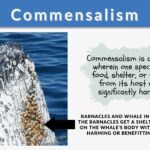
xxxTERMxxx
n., plural: xxxxxx
[kəˈmɛnsəˌlɪzm̩]
Definition: a symbiosis where only one benefits from the association while the other receives no significant harm or benefit from the association
Table of Contents
Commensalism Definition
What is commensalism? Literally, commensalism is a Latin word that means ‘to eat at the same table’. In biology, commensalism is a unique relationship between two species wherein one species draws food, shelter, or transport from the other without harming it. The interaction duration between two species varies from short to long. It is a kind of symbiotic relationship; however, one of the partners is neither benefited nor harmed. The partner that draws the benefit is known as a commensal while the other one is known as the host species. The word ‘commensalism’ was first described by the zoologist and palaeontologist Pierre-Joseph van Beneden who used this term to describe the behavior of scavengers to follow predators to feed upon the remains of dead animals.
Now let’s have some commensalism relationship examples. The simplest example of commensalism is a bird making a nest in a tree. The tree provides shelter and protection to the bird without getting significantly harmed or affected by the bird. Another typical example is the cattle egrets (birds) that feed upon the insects stirred up by the feeding cattle. Cattle egrets get their food without disturbing the cattle.
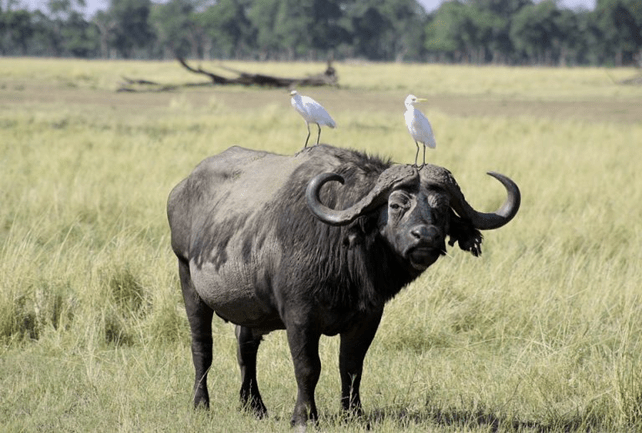
Orchids and ferns are epiphytes that grow on other plants. The canopy of high plants helps these epiphytes grow by supporting epiphytes in many ways. Epiphytes not only get support from these plants, but epiphytes also get exposure to sunlight and pollinators. However, they don’t draw food from the host plant, and hence the host plant remains unaffected by the orchids and ferns. However, orchids and ferns get the much-required support from the host plant.
Sea anemones and colorful clownfish also exhibit commensalism. Clownfish takes shelter in the sea anemone to protect themselves from predators. In the adaptation process, clownfish develop a mucous coating around themselves, allowing them to take refuge in the sea anemone without affecting its stings. Also, clownfish feed upon the debris of the last meal of sea anemones, thus keeping them clean.

The Viceroy butterfly mimics the monarch butterfly. This is because monarch butterflies are considered poisonous as they feed upon milkweeds. As a result, predators don’t prey upon monarch butterflies. Being similar to the monarch butterfly, the viceroy butterfly escapes predators.
Interestingly, monarch butterflies feeding upon milkweed is also an example of commensalism. Milkweeds contain toxic cardiac glycosides that can be poisonous to most vertebrates. The larvae of the monarch butterflies, a resident of North America, feed upon the toxic glycosides and store them in their body throughout their life. These butterflies remain unaffected by the presence of the poisonous glycosides in their body. However, birds and other predators do not feed upon the monarch butterflies due to providing upon and storing the toxic glycosides.
Similar to the viceroy butterflies, gobies are the small fishes that acquire the color of the animals they live upon. Thus, gobies escape from the predators while the host sea animals remain unaffected by the color-changing behavior of the gobies.
Barnacles are immobile crustaceans. However, the larvae of these crustaceans latch themselves to the whales or shells where these larvae grow and flourish. In addition, barnacles feed upon the planktons while whales are moving around. Thus, barnacles grow and thrive on whales’ surfaces and move from one place to another without affecting the host whale or shell.
Another crustacean, emperor shrimp, shares a commensal relationship with sea cucumbers. Emperor shrimps are light in weight and are found in the indo-pacific sea. These shrimps get latched to the sea cucumbers to protect themselves from predators and transportation.
Hermit crabs reside inside the shells of the dead snails. The snails remain unaffected by the commensal while the commensal gets a place to reside without affecting the host.
Mites are often considered the ultimate commensal. Though certain species of mites might be parasitic, species like Demodex folliculorum reside on the skin of humans and are perfect examples of commensalism.
Commensalism examples are found in every region of the world. We have seen plenty of examples of commensalism in the ocean. Let’s study some examples from other geographical regions of the world. Commensalism in the tundra is exhibited by caribou and the arctic fox relationship. Caribou exposes the lichen plant by digging them up. Reindeers get attracted to these lichens. Arctic foxes follow the caribou pathway and reach the reindeers feeding upon the exposed lichens.
Commensalism in savanna is exemplified by sub-Saharan African creature Oxpeckers and the grazing animals like giraffes, buffaloes, impalas, etc. Oxpeckers feed upon the flies, ticks, and insects found on the grazing animals. Oxpeckers thus feed upon these insects, flies, and ticks, keeping the animals clean.
Additionally, oxpeckers provide an alarm to the grazing animal if any predator is nearby or approaching the herd of the grazing animals. Thus, Oxpeckers and grazing animals exhibit a commensalism symbiotic relationship.
Similarly, golden jackals follow the tiger trail in order to feed upon the remains of the dead prey of the tiger. The tiger remains unaffected by the behavior of the jackal while the jackal gets easy access to the food.
Frogs from the family Dendrobatidae, known as Poison dart frogs found in the tropical regions of South and Central America, exhibit commensalism with leaves of large plants. These frogs take shelter under large leaves and protect themselves from predators.
Well, all the above are examples of commensalism in animals; one may wonder, What is an example of commensalism in humans?
Microbiota on the skin and gastrointestinal tract, wherein commensal bacteria flourish, is an example of commensalism in humans. Fungus Aspergillus grow in the gastrointestinal tract of humans and share commensalism with them. The human GI tract provides a suitable environment to grow without harming the host humans.
Here it is essential to differentiate commensalism from mutualism, parasitism, and amensalism.
The three relationships — mutualism commensalisms, and parasitism — are the type of organism that exhibits symbiosis. Depending upon the types of relationships in nature, organisms may be classified into the above three classes. Mutualism is the interspecies symbiotic relationship wherein both species benefit from their mutual relationship. While in parasitism, one organism benefits from the other, the other is harmed (Table 1).
Table 1: Difference between different types of symbiotic relationship, i.e., commensalism, mutualism, parasitism | ||
|---|---|---|
| Commensalism | Mutualism | Parasitism |
| Interspecies relationship wherein one is benefited while the other remains unaffected | Interspecies relationship wherein both the organisms benefit from their association | Interspecies relationship wherein one is benefited while the association harms the other |
| It is non-obligatory interspecies symbiosis commensalism | It is an obligatory interspecies association wherein both partners are in mutual symbiosis | It can be obligatory as well as non-obligatory interspecies association |
| Only one species draws benefit for its survival, while others remain unaffected | Both species depend on each other for their survival and benefit | Only one species draws benefit for its survival, while the other is harmed with the association |
| It is a positive association | It is a positive association | It is a negative association |
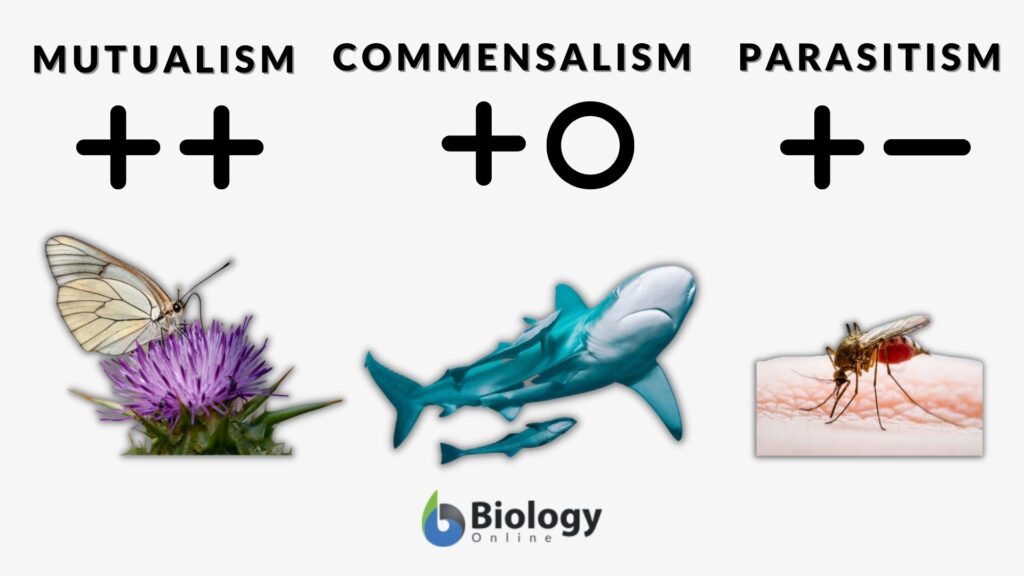
Amensalism is the unique interspecies relation wherein one of the organisms remains unaffected; however, the other is harmed [interestingly, the term ‘amensalism’ is a Latin word meaning ‘not on the table’].
Commensalism is a form of symbiosis between two organisms of different species in which the commensal benefits from the association whereas the host is largely unaffected or not significantly harmed or benefiting from the relationship. As a form of symbiosis, the organisms are typically found in close proximity despite their differences in speciation. Although they thrive in the same area there is no major competition between them. A common example is symbiosis between the epiphyte orchids on branches of trees. These orchids benefit from the trees by the trees rendering support to the orchids. The orchids can gain more light and air in this way. The trees are neither drastically harmed nor benefiting from the orchids attached to their branches.
Etymology: Latin com- (together) + mensa (table). See also: symbiosis
Types of Commensalism
Depending upon the purpose, strength, and duration of the association between commensal and host, commensalism is of the following types:
Phoresy
Phoresy is derived from a Greek word- ‘phorein’, which means to carry. In phoresy, the commensal organisms attach or latch to the host for the purpose of dispersal only. This relationship is temporary and is of short duration. Once the commensal reaches its desired location, the relationship ends. The commensal is often termed phoront. Usually, the phoront or the commensal is a nematode or mite with limited mobility. Example: barnacles latches on whales for transportation, so barnacles and whales are an example of phoresy commensalism animals.
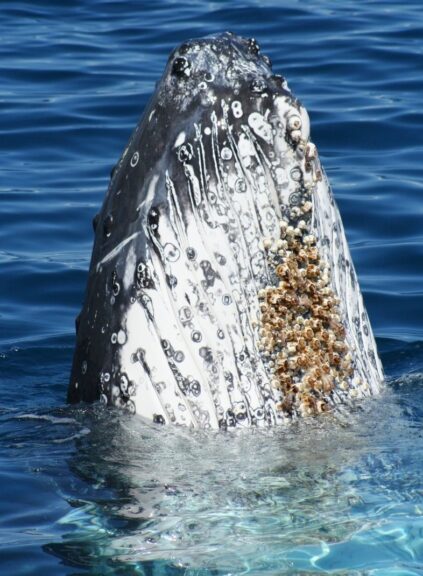
Figure 4: Phoresy relation between Whales and Barnacles Image source: hakaimagazine.com
Inquilinism
Inquilinism is the interspecies relationship wherein one organism dwell or resides on the other for a lifetime. In this relationship, the duration of the relationship is permanent. Example: Woodpecker drills a nest in the cactus

Metabiosis
As the name suggests, metabiosis is an interspecies relationship wherein one species creates bios or the environment favorable for the other to grow and flourish. In this commensalism, usually, the host is a deceased organism. Examples: bacterial growth on the dead animals; hermit crabs residing in the shells of dead snails
Watch this video of hermit crab changing shells
Microbiota
In this commensalism, the commensals grow inside the host to form a community. An example is the gut or skin microbiota in humans. Although there are conflicting views regarding classifying microbiota as a type of commensalism, recent studies have confirmed intestinal microbiota’s active and beneficial role in the healthy life of human beings. Historically, it is believed that the human gut provides shelter to the microbes without affecting the host human and thus categorized as commensalism. However, recent studies have proven that gut microbiota is a source of essential amino acids and other nutrients required for the healthy life of humans. Thus, the classification of microbiota as a type of commensalism is under review by scientists.
Commensalism Examples
Here are some of the examples of commensals and their host in commensalism.
Pseudoscorpions
Pseudoscorpions share a commensal relationship with beetles and bees. Pseudoscorpions are small scorpion-like insects that lack a sting. Instead, these small insects like creatures latch themselves to the host cells on their exposed surfaces like the fur or the wings. As a result of this relationship, pseudoscorpions gain protection from predators and weather along with the required transportation.
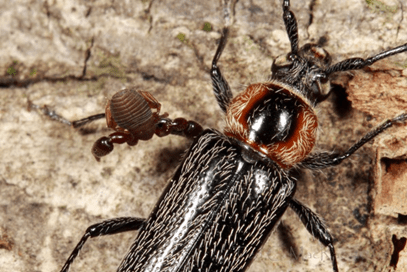
Bait fish and manta rays
Bait fishes travel along with manta ray fishes as manta ray fishes provide them with the required protection from predatory birds. Predatory birds don’t feed upon the bait fishes that travel along with the manta ray fishes. Thus, in this commensalism, the manta ray fishes remain unaffected by the presence of the bait fishes; however, bait fishes get protection from the predators.
Watch: Commensal relationship between Bait Fish and Manta Rays
Seed dispersal
Plants have devised many unique ways of seed dispersal. One such unique way of seed dispersal is of noxious weeds. The seeds of these weeds are Velcro-like and stick to the clothes of humans or the fur of other organisms. Once latched, these seeds travel from one place to the other along with the host without harming the host in any way.
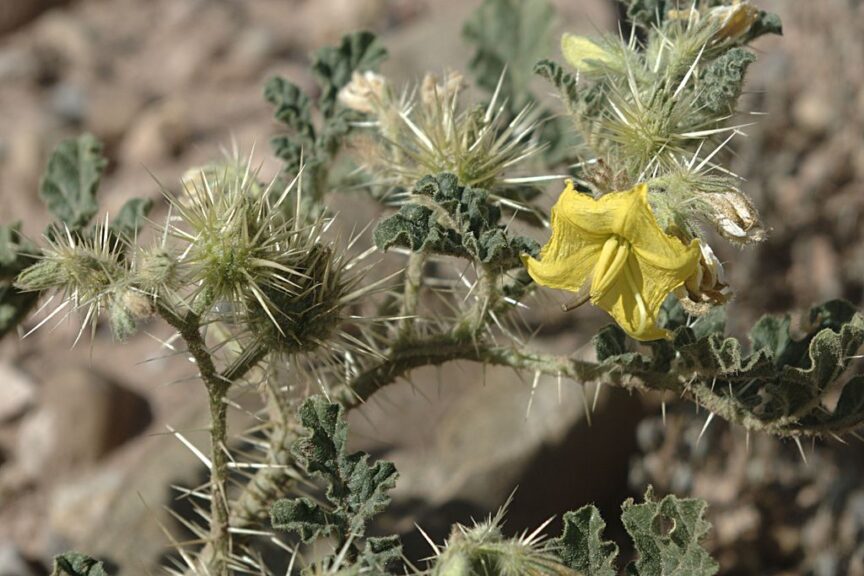
Try to answer the quiz below to check what you have learned so far about commensalism.
References
- Kasper D. L. (2009). A paradigm for commensalism: the role of a specific microbial polysaccharide in health and disease. Nestle Nutrition workshop series. Paediatric programme, 64, 1–257. https://doi.org/10.1159/000235779
- Mougi A. (2016). The roles of amensalistic and commensalistic interactions in large ecological network stability. Scientific reports, 6, 29929. https://doi.org/10.1038/srep29929
- Sætre, G. P., Riyahi, S., Aliabadian, M., Hermansen, J. S., Hogner, S., Olsson, U., Gonzalez Rojas, M. F., Sæther, S. A., Trier, C. N., & Elgvin, T. O. (2012). Single origin of human commensalism in the house sparrow. Journal of evolutionary biology, 25(4), 788–796. https://doi.org/10.1111/j.1420-9101.2012.02470.x
©BiologyOnline.com. Content provided and moderated by Biology Online Editors.


